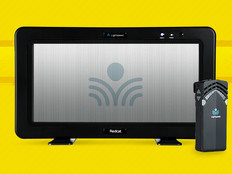Lesson Plans I
Color, Play, Podcast
Elementary school students share their learning with a wider audience over
the Web.
LESSON DESCRIPTION: Have your students ever been so excited when learning something that they were not quite ready to turn the page to the next topic? When this happens at Willowdale Elementary School in the Millard Public Schools in suburban Omaha, teachers have a ready solution: Students create a podcast of what they’ve learned.
Radio WillowWeb, a Web site (www.mpsomaha.org) that collects the elementary students’ podcasts, is produced for other students, but parents and other educators also listen regularly. Topics for podcasts may be selected by the teacher, but often are a result of student enthusiasm for a unit of study. Teachers follow these steps to create their podcasts:
- Students learn the format of a podcast and plan what content they will include.
- Working in small groups or with the whole class, students develop an outline.
- Students practice reading their scripts to other students.
- Recording takes place outside the classroom; the technology teacher edits the content and publishes it on the school’s Web site.
SUBJECT AREA: Reading and writing are the most obvious curricular connections. Depending on the topic, the podcast can include any other unit the students are studying.
Standards: Podcasting ties into several Nebraska State Standards. This lesson specifically meets two Nebraska Reading/Writing Standards:
- By fourth grade, students will use multiple forms to write for different audiences and purposes
- By eighth grade, students will revise and edit written work for organization, content, word choice (vocabulary), voice, sentence fluency, and standard English
RESOURCES: Students need access to the Web and print materials for research. Willowdale uses digital audio recording software to record and enhance podcasts. The only other necessary equipment is a USB headset microphone. To complete publishing, you need access to a Web server. A podcast requires a Web page and an RSS feed.
These Web sites include reference and tutorial assistance:
- Educational consultant Tony Vincent’s Web site has a download for the planning sheets used for Radio WillowWeb, as well as step-by-step instructions for creating podcasts: www.learninginhand.com
- Educational author Dan Schmit provides general information about podcasting in the classroom: www.intelligenic.com/blog
GRADING RUBRIC: Each classroom teacher can score podcasting materials with writing rubrics linked to Vicki Spandel’s book, Creating Young Writers: Using the Six Traits to Enrich Writing Process in Primary Classrooms. Primary teachers don’t give podcast grades, instead focusing on the writing experience and process.
Teaching Tips
- To create PC podcasts, the free software Audacity is recommended for recording. Making the music requires additional software.
- Publicize your podcast by advertising it on your school’s home page. Expand your audience by submitting the Web address of your RSS feed to podcast directories.
- Try to keep the podcast 10 minutes or shorter, especially if your audience is elementary school students.






